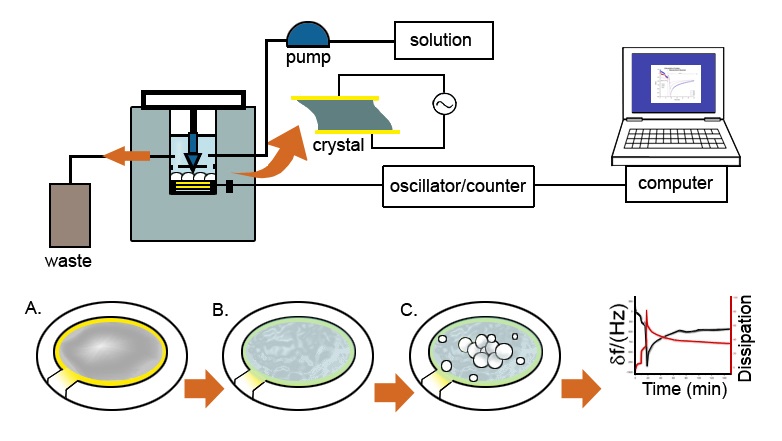Introduction: Bioactive glasses (BAG) are known to form apatites, typically substituted forms of hydroxyapatite (Ca10(PO4)6(OH)2), the inorganic component of bone and teeth[1]. Currently accepted in vitro models[2] used to study BAG dissolution involve material agitation in fluids without flow. Here we present a method of measuring relative mass changes of a deposited BAG and calcium phosphate precipitate under static and flow conditions using a Quartz Crystal Microbalance (QCM). This technique allows the kinetics of glass transformation to be followed and compared to traditional static models.
Material and Methods: A QCM flow cell has been modified to allow the controlled addition of BAG directly onto quartz crystal sensors, Fig 1. Sensors are cleaned with solvent, dried and cleaned with UV/Ozone to remove any organics from the TiO2 surface of the sensors. Sensors are then placed into the QCM to be stabilised with TRIS buffer or Artificial Saliva (AS), static or under flow. Once hydration of the sensor is complete and a stable signal is found 500 µL of BAG suspension in fluid (TRIS/AS) is pipetted onto the modified sensor. In parallel an ion selective electrode and pH probe are used to monitor the fluid within the QCM for the purposes of comparing to traditional bioactivity results. Fluid exiting the QCM is collected at specific time points for measurement by ICP.
Results: A comparison of the influence of fluid/buffer choice is shown to substantially change the process of the BAG reaction and we are also able to observe the difference in BAG particle size (surface area). Using fluids with additional ions (AS) shows greater deposition than TRIS, which fits with the conservation of mass. Points of inflection for an increase mass deposition can be seen with artificial saliva with a decrease on time of onset with increasing surface area of the BAG.
Conclusion: Using this modified QCM model we are able to follow the BAG transformation kinetics in real time. Further work could be undertaken with this model to look at the effects from proteins on nucleation and the effect of cells under the influence of bioactive glasses.

References:
[1] R. LeGEros, Calcium Phosphates in Oral Biology, New York: Karger, 1991.
[2] Maçon, A.; Kim, T.; Valliant, E.; Goetschius, K.; Brow, R.; Day, D.; Hoppe, A.; Boccaccini, A.; Kim, I.; Ohtsuki, C.; Kokubo, T.; Osaka, A.; Vallet-Regí, M.; Arcos, D.; Fraile, L.; Salinas, A.; Teixeira, A.; Vueva, Y.; Almeida, R.; Miola, M.; Vitale-Brovarone, C.; Verné, E.; Höland, W. & Jones, J. A unified in vitro evaluation for apatite-forming ability of bioactive glasses and their variants Journal of Materials Science: Materials in Medicine, Springer US, 2015, 26